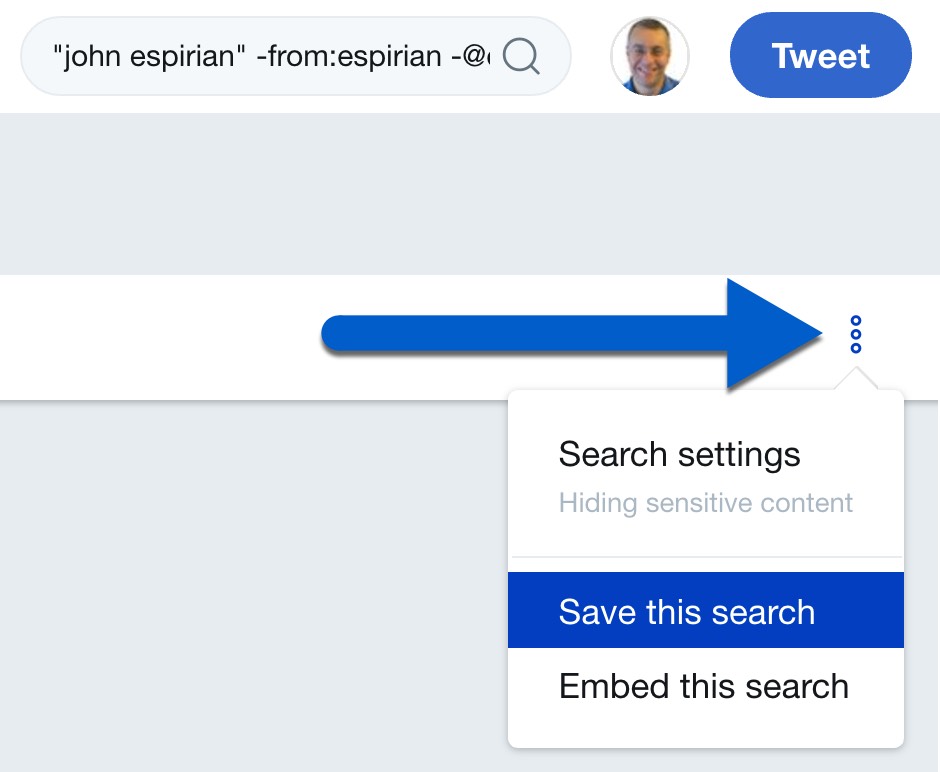Who is talking about you but not tagging you on Twitter?
Do you want to make sure that you don’t miss any mentions of your name on Twitter? This post gives you a magic search string to save so that can easily check it in future.
If you know what you’re doing, here’s a sample search string for you to rewrite:
Search Twitter for mentions of your name
"john espirian" -from:espirian -@espirian
Search Twitter for links to your content
espirian.co.uk -from:espirian -@espirian
- Introduction – “untagged” mentions
- The magic search string
- Saving the search
- A couple of real search examples
- Bonus tip: Searching for questions on Twitter
- Let’s wrap up
Introduction – “untagged” mentions
Twitter’s Notifications tab will let you know whenever another user sends you a reply or mentions your username.
But you won’t get a notification if someone mentions your name in plain text rather than using your username (the bit that starts with the @ symbol).
For example, here’s a tweet that mentions me by name but doesn’t use my username (@espirian):
Top 10 #proofreading tips by John Espirian https://t.co/pSZEgUANB1
— Marion Bazzoli Ⓥ (@MarionBazzoli) March 14, 2019
Here’s another tweet that doesn’t mention my name at all:
Do you send out #LinkedIn invitations? Do you personalise them? What's that? You can't on a mobile? Yes, you can! And here's how. https://t.co/6X2zJhDiZU
— MPS Networks Limited (@mps_networks) May 3, 2019
These are what I’d call “untagged” mentions. These can happen for a few reasons:
- People forget to tag you: can’t be helped – we’re all short on time.
- People can’t find the right username: help them by including your real name in your Twitter profile and making your Twitter username visible on your website and in your blog posts.
- People are talking about you behind your back: this is called subtweeting and isn’t good practice – but you can still dig up these tweets to see what’s being said.
The magic search string
To search for untagged mentions, you need to use a search string similar to this:
Twitter’s magic search string
"john espirian" -from:espirian -@espirian
Let’s break down how that works so that you can use it on your own account. The search string is made of 3 parts:
Part 1 of the magic search string
The first part is the search term you’re looking for.
In this case, I want to look for mentions of my full name, so I write it in quotes:
"john espirian"
Part 2 of the magic search string
The second part uses the minus/hyphen symbol to exclude tweets I’ve made myself.
The from prefix means that the @ symbol should be omitted from the username:
-from:espirian
Part 3 of the magic search string
The third part uses the minus/hyphen symbol to exclude tweets that mention my username.
This time the @ symbol is required:
-@espirian
Stick all the parts together and you get the full search query:
Twitter’s magic search string
"john espirian" -from:espirian -@espirian
But that’s not all. You can use the same method to search Twitter for shares of your content.
To do that, change the first part of the search string from your name to your website domain.
Here’s an example:
Search Twitter for links to your content
espirian.co.uk -from:espirian -@espirian
Saving the search
If you type the magic search string (or any other search) into the desktop version of Twitter, you’ll be able to save the search for next time by using the vertical ellipsis menu (3 dots) in the top-right corner.

Note for Twitter mobile users
You can’t save new searches in the mobile version of Twitter but you can reuse existing saved searches there.
The following example appears truncated but the whole search is saved and does work:

A couple of real search examples
If I were to apply this method to a lookup for my web design buddy, Martin Huntbach, I’d write the search like this:
"martin huntbach" -from:martinhuntbach -@martinhuntbach
Lo and behold, it reveals tweets like this:
7 reasons you shouldn't hire @Jammy_Digital to design your website: https://t.co/M9M4vXW5bQ
Transparency epitomised by Martin Huntbach 💎
— John Espirian (@espirian) March 21, 2017
(The search also reveals lots of tweets from someone else with the same name, but those are easily filtered out by adding another -from:username part to the search string.)
Here’s another example for my proofreader buddy, Louise Harnby:
"louise harnby" -from:louiseharnby -@louiseharnby
And here’s a typical result:
How publishing professionals can stretch their marketing budget https://t.co/KAg2bC6c3X via @bookmachine The lovely Louise Harnby.
— Victoria Woodside (@vicproofreader) June 9, 2017
Note that in each of these cases, the person is mention but their Twitter username isn’t. That means they won’t have received a notification, and so the tweet may well have gone unacknowledged.
If you want to make sure this doesn’t happen to you, rewrite the search string to suit your name and details, and then save it for future reference.
Use the magic search string to find common misspellings of your name.
In my case, I’ll also search for Esperian, Experian (ugh!) and Aspirin (UGHHH!).
Bonus tip: Searching for questions on Twitter
If you add a question mark to Twitter searches, the results will display only tweets that include a question.
This is a great way to learn about what people are searching for on a given topic, and could be a good source of topics to write about in your blogs.
Let’s wrap up
The notifications feature in Twitter is pretty good, but saving this advanced search string will help you make sure you don’t let any “untagged” mentions slip through the net.
Who knows: perhaps you’ll discover some cool people have been sharing your stuff without telling you!
Want even more Twitter search tips? Check out my Twitter advanced search guide.


